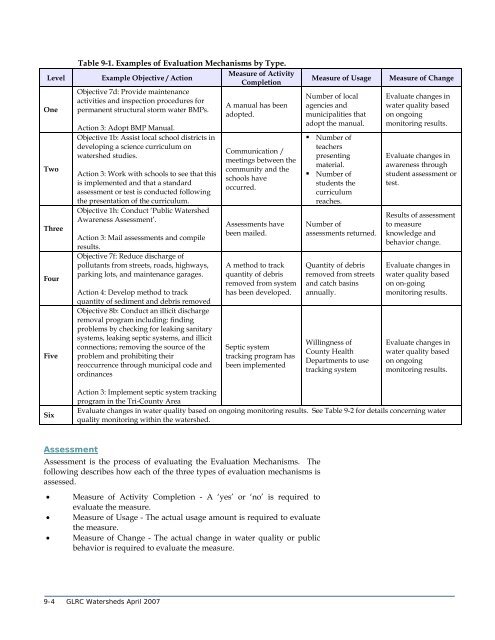Looking Glass River Watershed Management Plan - Greater ...
Looking Glass River Watershed Management Plan - Greater ...
Looking Glass River Watershed Management Plan - Greater ...
Create successful ePaper yourself
Turn your PDF publications into a flip-book with our unique Google optimized e-Paper software.
Level<br />
One<br />
Two<br />
Three<br />
Four<br />
Five<br />
Table 9-1. Examples of Evaluation Mechanisms by Type.<br />
Measure of Activity<br />
Example Objective / Action<br />
Completion<br />
Objective 7d: Provide maintenance<br />
activities and inspection procedures for<br />
A manual has been<br />
permanent structural storm water BMPs.<br />
adopted.<br />
Action 3: Adopt BMP Manual.<br />
Objective 1b: Assist local school districts in<br />
developing a science curriculum on<br />
watershed studies.<br />
Action 3: Work with schools to see that this<br />
is implemented and that a standard<br />
assessment or test is conducted following<br />
the presentation of the curriculum.<br />
Objective 1h: Conduct ‘Public <strong>Watershed</strong><br />
Awareness Assessment’.<br />
Action 3: Mail assessments and compile<br />
results.<br />
Objective 7f: Reduce discharge of<br />
pollutants from streets, roads, highways,<br />
parking lots, and maintenance garages.<br />
Action 4: Develop method to track<br />
quantity of sediment and debris removed<br />
Objective 8b: Conduct an illicit discharge<br />
removal program including: finding<br />
problems by checking for leaking sanitary<br />
systems, leaking septic systems, and illicit<br />
connections; removing the source of the<br />
problem and prohibiting their<br />
reoccurrence through municipal code and<br />
ordinances<br />
Communication /<br />
meetings between the<br />
community and the<br />
schools have<br />
occurred.<br />
Assessments have<br />
been mailed.<br />
A method to track<br />
quantity of debris<br />
removed from system<br />
has been developed.<br />
Septic system<br />
tracking program has<br />
been implemented<br />
Measure of Usage<br />
Number of local<br />
agencies and<br />
municipalities that<br />
adopt the manual.<br />
• Number of<br />
teachers<br />
presenting<br />
material.<br />
• Number of<br />
students the<br />
curriculum<br />
reaches.<br />
Number of<br />
assessments returned.<br />
Quantity of debris<br />
removed from streets<br />
and catch basins<br />
annually.<br />
Willingness of<br />
County Health<br />
Departments to use<br />
tracking system<br />
Measure of Change<br />
Evaluate changes in<br />
water quality based<br />
on ongoing<br />
monitoring results.<br />
Evaluate changes in<br />
awareness through<br />
student assessment or<br />
test.<br />
Results of assessment<br />
to measure<br />
knowledge and<br />
behavior change.<br />
Evaluate changes in<br />
water quality based<br />
on on-going<br />
monitoring results.<br />
Evaluate changes in<br />
water quality based<br />
on ongoing<br />
monitoring results.<br />
Six<br />
Action 3: Implement septic system tracking<br />
program in the Tri-County Area<br />
Evaluate changes in water quality based on ongoing monitoring results. See Table 9-2 for details concerning water<br />
quality monitoring within the watershed.<br />
Assessment<br />
Assessment is the process of evaluating the Evaluation Mechanisms. The<br />
following describes how each of the three types of evaluation mechanisms is<br />
assessed.<br />
• Measure of Activity Completion - A ‘yes’ or ‘no’ is required to<br />
evaluate the measure.<br />
• Measure of Usage - The actual usage amount is required to evaluate<br />
the measure.<br />
• Measure of Change - The actual change in water quality or public<br />
behavior is required to evaluate the measure.<br />
9-4 GLRC <strong>Watershed</strong>s April 2007





